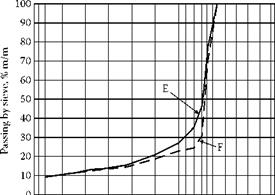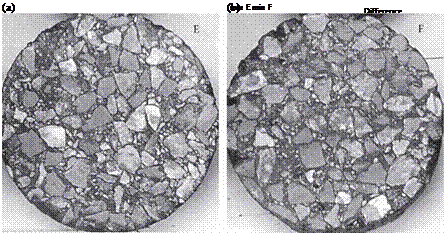REQUIREMENTS FOR AN SMA MIXTURE DESIGN
Volumetric properties are among the most frequently cited requirements for SMA mixtures checked at the laboratory level. The primary requirement is to ensure the needed content of voids in compacted samples. Mechanical requirements (e. g., stability) are seldom determined, whereas performance-related properties (e. g., resistance to rutting) can be more often seen in specifications. Table 6.13 shows a short summary of different types of requirements. The corresponding summary of requirements for SMA in accordance with the European classification system after EN 13108-5 can be found in Chapter 14.
Requirements for laboratory-designed SMA mixtures according to the European standard EN 13108-5 can be found in Chapter 14 (see Table 14.3).
Upon completing the design of an aggregate mix and the contents of binder and stabilizer (see Chapter 8), it is worth investigating whether the properties of a newly prepared SMA mixture can yield the characteristics required by the customer after construction. A more detailed description of those qualities and related research may be found in Chapters 10 and 12.
Summary of Requirements for SMA Mixtures in Various Countries
|
TABLE 6.13
(Continued) |
|
TABLE 6.13 (CONTINUED) Summary of Requirements for SMA Mixtures in Various Countries
Note: AASHTO = American Association of State Highway and Transportation Officials; PRD = Proportional Rut Depth, result of WTT; SMA = stone matrix asphalt; VMA = voids in mineral aggregate; WTS = wheel tracking slope, result of WTT; WTT = wheel tracking test. a If samples are prepared with gyratory compactor, the maximum density is read after 300 or 350 gyrations. b Since 2006 requirements in European CEN members have to be established according to EN 13108-5 and test methods in EN 12697 with test conditions as in EN 13108-20. |
6.5 summary
• SMA mixtures may be used both in wearing and intermediate layers.
• The suggested minimum thickness of a course equals 3.5-4 times the maximum aggregate size.
• As a general rule, heavy traffic loadings require coarser mixtures. In these cases the mixtures 0/11 and 0/12.5 mm are the most popular solutions. Unfortunately, such mixtures also have weak points, including low noise reduction, higher permeability, and worse antiskidding properties in comparison with finer mixtures.
• The coarse aggregate fraction
• When one designs the composition of the coarse aggregate fraction, to achieve the best gap-gradation the percentages of the finest and intermediate fractions should be reduced but the proportion of the coarsest ones should be increased.
• An increase in the content of air voids in the aggregate mix and the amount of binder in SMA result from an increase in the coarse aggregate content. Specifying the content of particles larger than 2 mm in an SMA aggregate mix does not explicitly determine either its aggregate structure or its properties; it is necessary to supply information on the amount of particles larger than 5 or 8 mm (or similar sieves).
• Increasing the share of particles larger than 5 mm leads to opening the mix; that effect is even more obvious when increasing the content of particles larger than 8 mm. Therefore, manipulating the content of the coarsest grains offsets the strongest impact on changes in the content of air voids within the coarse aggregate fraction.
• Designing SMA with a very high content of the coarsest particles brings about the necessity of adding a larger amount of binder, and possibly more stabilizer too. Such mixtures are also characterized by higher permeability and greater compaction resistance.
• Increasing the quantity of flat and elongated particles in a mixture has the following effects:
– Increases the content of air voids in an aggregate mix
– Diminishes the workability of the mix
– Increases the risk of crushing the flat and elongated particles during compaction (followed by squeezing mastic out)
• The sand fraction and filler
• Designing an SMA using the maximum quantity of filler and the minimum amount of fine aggregate is disadvantageous
• The quantity of filler should generally be near the middle of the allowable range, which means about 9-10% (m/m), to enable an appropriate amount of 0.063/2-mm material on sieves less than 1.0 mm.
• Using high quantities of natural (non-crushed) sand should be avoided, and for SMAs created for heavy traffic, its use should be generally excluded.
• A surplus of mastic in comparison with the void space among chip – pings causes the appearance of fat spots and a local decrease in antiskid properties.
• Too low a quantity of mastic means a too large an air void content in a compacted course, high absorption and water permeability, and consequently a shorter life.
• The binder content
• Corrective coefficients of the binder content that are dependent on the aggregate density should be used.
• The content of air voids in an SMA mixture design should not be adjusted by changing the binder content; it should be done with corrections of contents and gradation of the aggregate fractions, including the following:
– The content of the coarse aggregate fraction (see Section 6.3.1.1)
– The ratios of constituents within the coarse aggregate fraction (see Section 6.З.1.2.)
– Filler content
– Binder content, as a final resort
• The content of VMA can be evidence of problems with air voids in compacted SMA specimens; an increase in VMA should be achieved by adding coarser chippings (more material retained on a 4 mm or 5 mm sieve) or by decreasing the amount of filler, while a decrease in VMA should be achieved by adding finer chippings.
• When comparing volume requirements of various guidelines, one should keep in mind major differences in procedures for determining density, which eventually change the range of results.









 0
0

